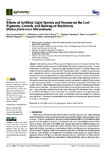Effects of Artificial Light Spectra and Sucrose on the Leaf Pigments, Growth, and Rooting of Blackberry (Rubus fruticosus) Microshoots
| dc.contributor.author | Dewir, YH | |
| dc.contributor.author | Al-Ali, AM | |
| dc.contributor.author | Rihan, HZ | |
| dc.contributor.author | Alshahrani, T | |
| dc.contributor.author | Alwahibi, MS | |
| dc.contributor.author | Almutairi, KF | |
| dc.contributor.author | Naidoo, Y | |
| dc.contributor.author | Fuller, MP | |
| dc.date.accessioned | 2023-02-20T11:05:12Z | |
| dc.date.available | 2023-02-20T11:05:12Z | |
| dc.date.issued | 2022-12-27 | |
| dc.identifier.issn | 2073-4395 | |
| dc.identifier.issn | 2073-4395 | |
| dc.identifier.other | ARTN 89 | |
| dc.identifier.uri | http://hdl.handle.net/10026.1/20439 | |
| dc.description.abstract |
<jats:p>Light emitting diodes (LEDs) are potential light sources for in vitro plant cultures. Here, axillary blackberry shoots were grown in MS medium with indole-3-butyric acid (1 mg L−1), naphthalene acetic acid (0.5 mg L−1), and sucrose supplementation (0–60 g L−1) and the cultures were incubated under four light treatments: three LED light treatments (blue + red light (2:1 spectral ratio), blue + red light (1:2), and cool + warm white light (1:1)) and a standard florescent tube white spectrum treatment. Sucrose was indispensable for rooting of blackberry microshoots. Sucrose concentrations up to 45 g L−1 increased total root length and root surface area under all light treatments. However, at this sucrose concentration, leaf area and vegetative growth were negatively affected. Plantlets grown in media containing 15–30 g L−1 of sucrose exhibited the highest leaf pigments, shoot length, and number of leaves. LED treatments increased leaf pigments as compared with florescent treatment. Plantlets grown under blue + red light (2:1) had the highest stoma aperture length and width, whereas cool + warm white light resulted in the lowest values. Among the LED treatments, blue + red light (2:1) resulted in the highest leaf area, chlorophyll and carotenoid contents, and vegetative growth, whereas fluorescent resulted in the lowest values. A combination of blue and red light at a 2:1 spectral ratio with 30 g L−1 of sucrose is recommended for the optimal in vitro rooting and vegetative growth of blackberry microshoots.</jats:p> | |
| dc.format.extent | 89-89 | |
| dc.language | en | |
| dc.language.iso | en | |
| dc.publisher | MDPI AG | |
| dc.subject | in vitro | |
| dc.subject | light quality | |
| dc.subject | micropropagation | |
| dc.subject | stomata | |
| dc.subject | tissue culture | |
| dc.title | Effects of Artificial Light Spectra and Sucrose on the Leaf Pigments, Growth, and Rooting of Blackberry (Rubus fruticosus) Microshoots | |
| dc.type | journal-article | |
| dc.type | Article | |
| plymouth.author-url | https://www.webofscience.com/api/gateway?GWVersion=2&SrcApp=PARTNER_APP&SrcAuth=LinksAMR&KeyUT=WOS:000914356000001&DestLinkType=FullRecord&DestApp=ALL_WOS&UsrCustomerID=11bb513d99f797142bcfeffcc58ea008 | |
| plymouth.issue | 1 | |
| plymouth.volume | 13 | |
| plymouth.publication-status | Published online | |
| plymouth.journal | Agronomy | |
| dc.identifier.doi | 10.3390/agronomy13010089 | |
| plymouth.organisational-group | /Plymouth | |
| plymouth.organisational-group | /Plymouth/Faculty of Science and Engineering | |
| plymouth.organisational-group | /Plymouth/Faculty of Science and Engineering/School of Biological and Marine Sciences | |
| plymouth.organisational-group | /Plymouth/Users by role | |
| plymouth.organisational-group | /Plymouth/Users by role/Academics | |
| dcterms.dateAccepted | 2022-12-26 | |
| dc.rights.embargodate | 2023-2-21 | |
| dc.identifier.eissn | 2073-4395 | |
| dc.rights.embargoperiod | Not known | |
| rioxxterms.versionofrecord | 10.3390/agronomy13010089 | |
| rioxxterms.licenseref.uri | http://www.rioxx.net/licenses/all-rights-reserved | |
| rioxxterms.type | Journal Article/Review |


